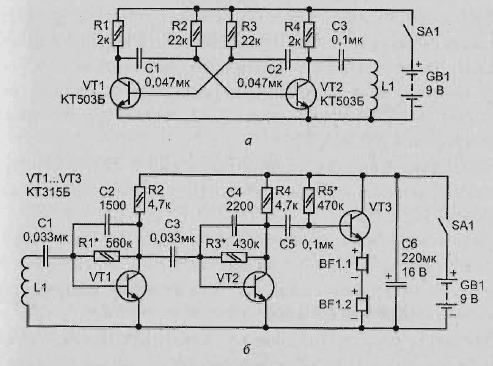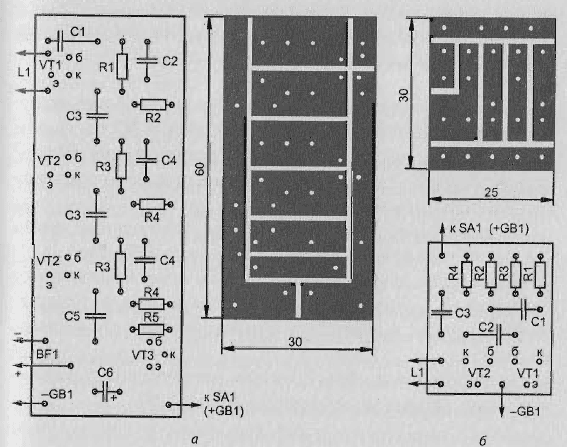
|
|
ENCYCLOPEDIA OF RADIO ELECTRONICS AND ELECTRICAL ENGINEERING A simple metal detector operating on the Transmit-Receive principle. Encyclopedia of radio electronics and electrical engineering
Encyclopedia of radio electronics and electrical engineering / metal detectors Operating principle A multivibrator was used as a transmitter, and an audio frequency amplifier was used as a receiver. Coils of the same size and winding data are connected to the output of the first of these devices and the input of the second. In order for the system of such a transmitter and receiver to become a metal detector, it is necessary to arrange the coils so that in the absence of foreign metal objects there is practically no connection between them, i.e. the transmitter signal does not go directly to the receiver. As is known, the inductive coupling between the coils is minimal if their axes are mutually perpendicular. Therefore, if the transmitter and receiver coils are positioned in this way, then the transmitter signal in the receiver will not be heard. When a metal object appears near this balanced system, under the influence of the alternating magnetic field of the transmitting coil, so-called "eddy currents" arise in it and, as a result, its own magnetic field, which induces an alternating EMF in the receiving coil. The signal received by the receiver is converted by phones into sound. Its volume depends on the size of the object and the distance to it. Technical specifications The technical characteristics of the metal detector are as follows:
Schematic diagram of the transmitter The transmitter circuit is shown in fig. 2.13, a. This is a symmetrical multivibrator on transistors VT1, VT2. The frequency of the oscillations it generates is determined by the capacitance of the capacitors C1, C2 and the resistance of the resistors R2, R3. The audio frequency signal from the collector load of the transistor VT2 - resistor R4 - through the decoupling capacitor C3 is fed to the coil L1, which converts electrical oscillations into an alternating magnetic field. Receiver circuit diagram The receiver is a three-stage audio frequency amplifier, made according to the circuit shown in Fig. 2.13b. At its input, the same coil L1 is included as in the transmitter. The output of the amplifier is loaded with BF1 telephones connected in series.
The work of the metal detector according to the concept An alternating magnetic field of the transmitter, induced by a coil in a metal object, acts on the receiver coil. As a result, an electric current with a frequency of about 2 kHz arises in it. Through the separating capacitor C1, the signal is fed to the input of the first stage of the amplifier, made on the transistor VT1. The amplified signal from its load - resistor R2 - is fed through a decoupling capacitor C3 to the input of the second stage, assembled on a transistor VT2. The signal from its collector through the capacitor C5 is fed to the input of the third stage - the emitter follower on the transistor VT3. It amplifies the current signal and allows you to connect low-resistance phones as a load. To reduce the effect of ambient temperature on the stability of the amplifier, a negative DC voltage feedback was introduced into the first and second stages by turning on: resistor R1 between the collector and the base of the transistor VT1; resistor R3 between the collector and base VT2. Gain reduction at frequencies below 2 kHz is achieved by an appropriate choice of the capacitance of separating capacitors C1, C3. Gain reduction at frequencies above 2 kHz - by introducing into the first and second stages a frequency-dependent negative feedback on alternating voltage through capacitors C2 and C4. These measures made it possible to increase the noise immunity of the receiver. Capacitor C6 prevents the amplifier from self-exciting when the internal resistance of the battery increases as it discharges. Coil Making Recommendations The receiver and transmitter coils are the same. You can make them in the following way. At the corners of a rectangle measuring 115 x 75 mm, drive four nails into the board: 2-2,5 mm in diameter; 50-60 mm long. First you need to put PVC or polyethylene tubes 30-40 mm long on the nails. This will give sufficient insulation to the entire structure. On nails isolated in this way, 300 turns of PEV-2 wire with a diameter of 0,12-0,14 mm should be wound. Upon completion of winding, wrap the turns around the entire perimeter with a narrow strip of insulating tape. The nails can then be bent back to remove the coil. Metal detector design It is desirable to use polystyrene boxes as receiver and transmitter housings (internal dimensions - 120 x 80 mm). Battery compartments, PCB racks and coil fastening elements can be made of the same material and glued to the housings with P-647 solvent (P-650 can also be used). Sketches of printed circuit boards and the location of parts are shown in fig. 2.14, a-b.
All metal structural elements located inside the receiver and transmitter coils (power battery, parts board, power switch) affect their magnetic field. To exclude a possible change in their position during operation, all of them must be securely fastened. This is especially true of the Krona battery as a replaceable structural element. Establishment To check the operation of the transmitter, instead of the L1 coil, you need to connect phones and make sure that sound is heard in the phones when the power is turned on. Then, having connected the coil in place, control the current consumed by the transmitter. It should be within 5-7 mA. The receiver is tuned with the input short-circuited. By selecting a resistor R1 in the first stage and R3 in the second, a voltage equal to about half the supply voltage should be set on the collectors of the transistors VT1 and VT2, respectively. Then, by selecting the resistor R5, you need to ensure that the collector current of the transistor VT3 becomes equal to 5-7 mA. After that, having opened the input, connect the L1 receiver coil to it and, receiving the transmitter signal at a distance of about 1 m, make sure that the system as a whole is working. Author: Solonenko V.
Artificial leather for touch emulation
15.04.2024 Petgugu Global cat litter
15.04.2024 The attractiveness of caring men
14.04.2024
▪ If aliens exist, we will know about them in the next 20 years ▪ Artificial glacier against global warming
▪ section of the site Power supply. Article selection ▪ article State and municipal finance. Crib ▪ article Which of the sex symbols most of his life could not experience an orgasm? Detailed answer ▪ article Master's assistant. Standard instruction on labor protection
Comments on the article: Novel How are metal detector frames installed correctly? I set them up for two days. It squeaks incessantly, even when there is no metal nearby at all, then it doesn’t squeak even next to a hundred-liter tank. a guest Show on the photo what the assembled metal detector looks like
Home page | Library | Articles | Website map | Site Reviews www.diagram.com.ua |






 Arabic
Arabic Bengali
Bengali Chinese
Chinese English
English French
French German
German Hebrew
Hebrew Hindi
Hindi Italian
Italian Japanese
Japanese Korean
Korean Malay
Malay Polish
Polish Portuguese
Portuguese Spanish
Spanish Turkish
Turkish Ukrainian
Ukrainian Vietnamese
Vietnamese


 Leave your comment on this article:
Leave your comment on this article: